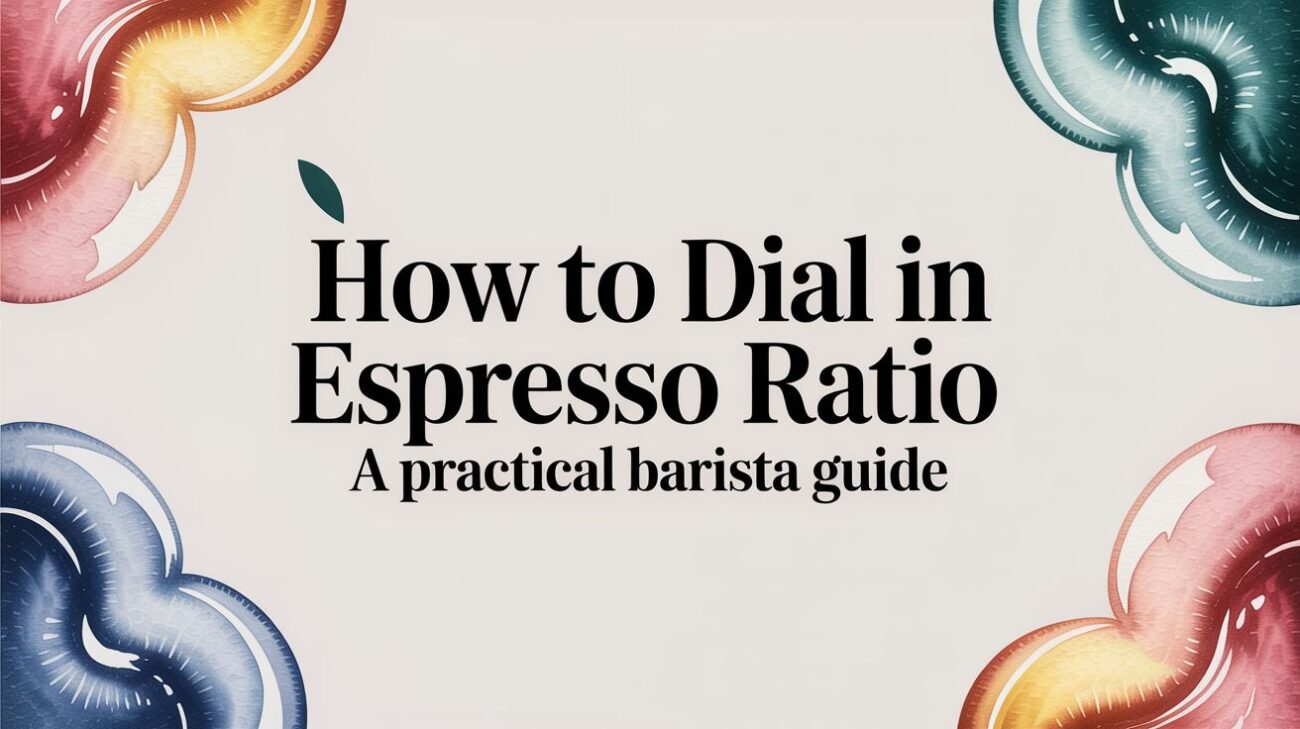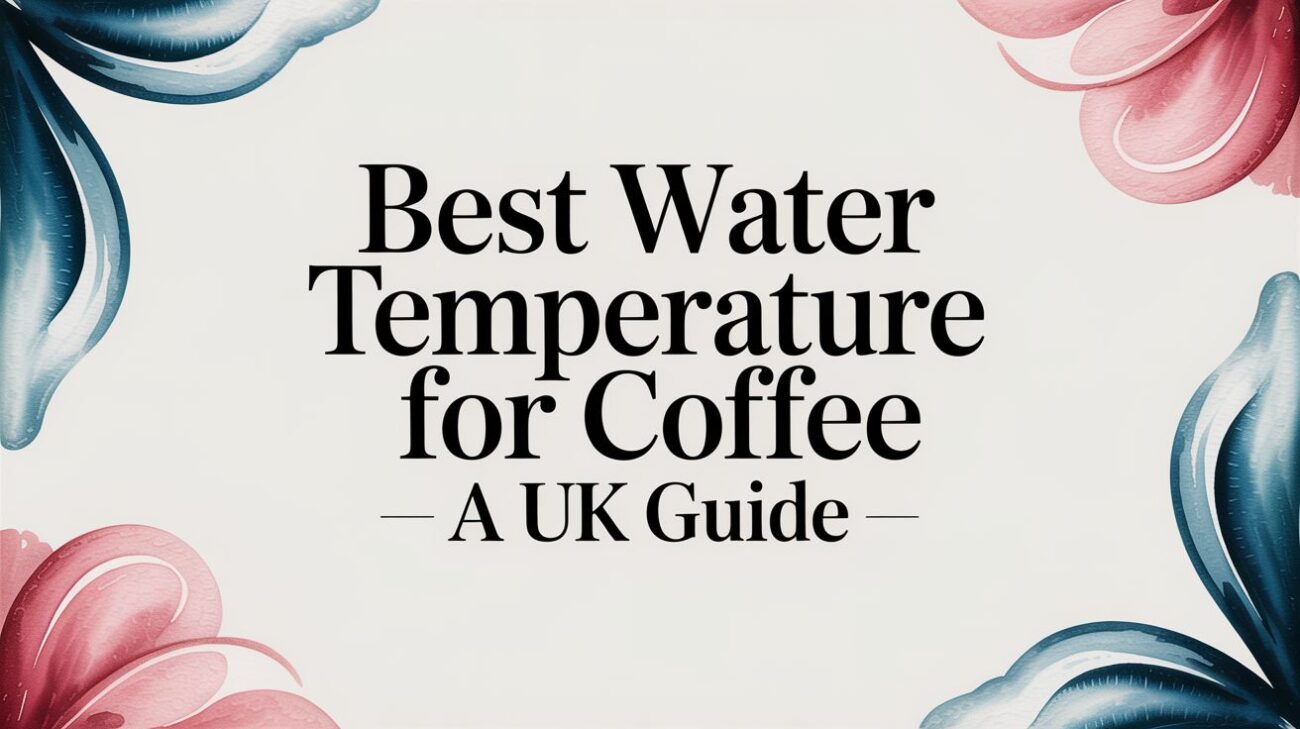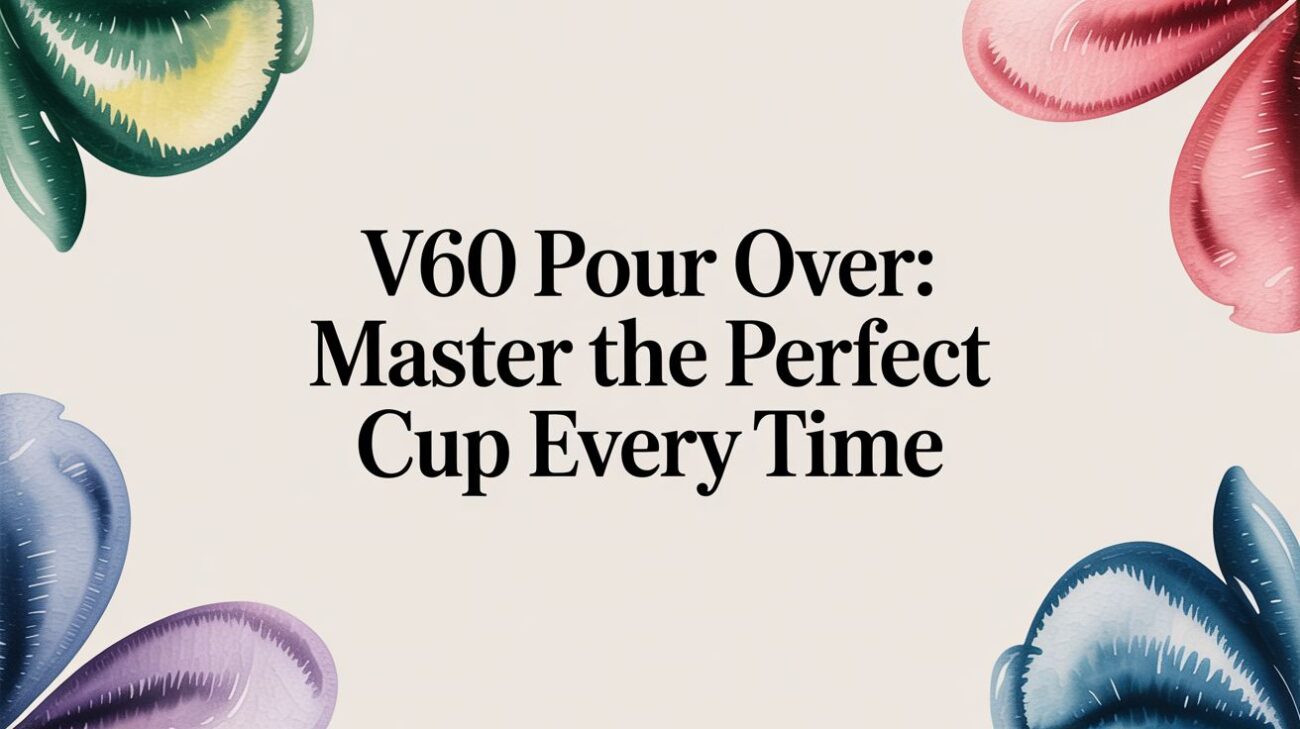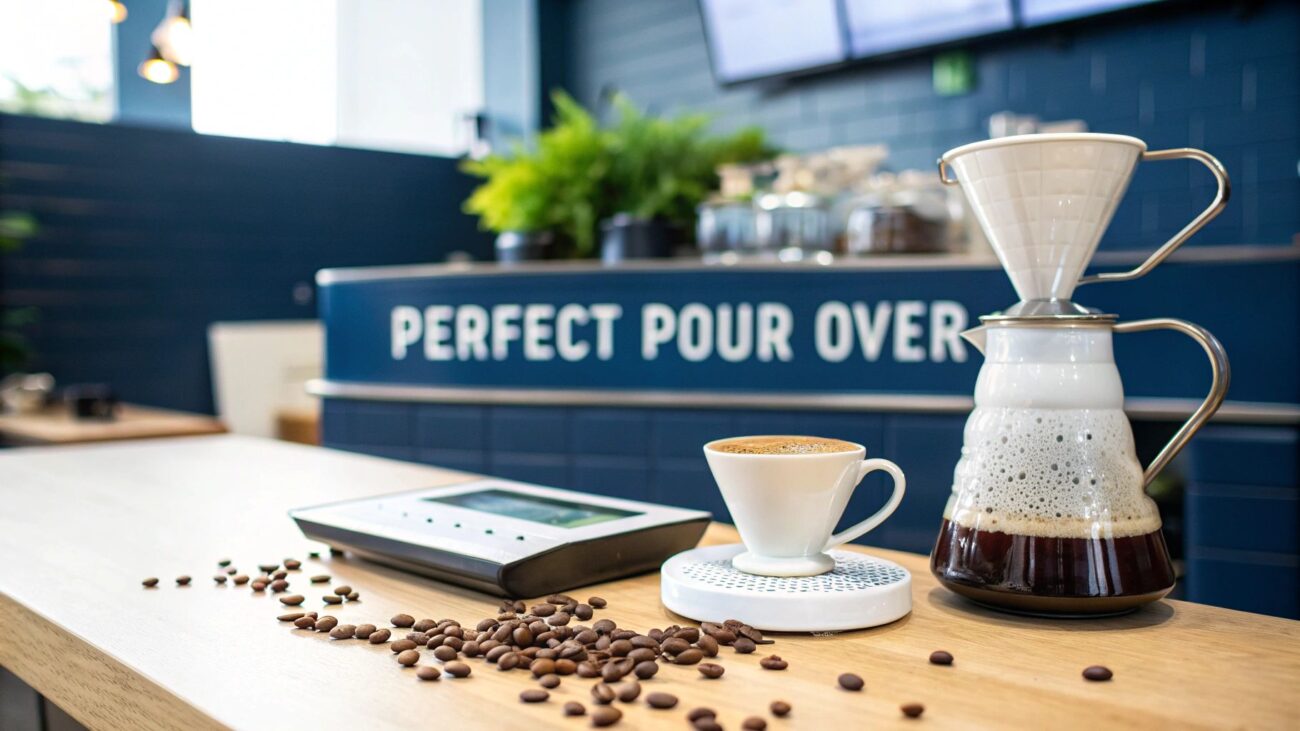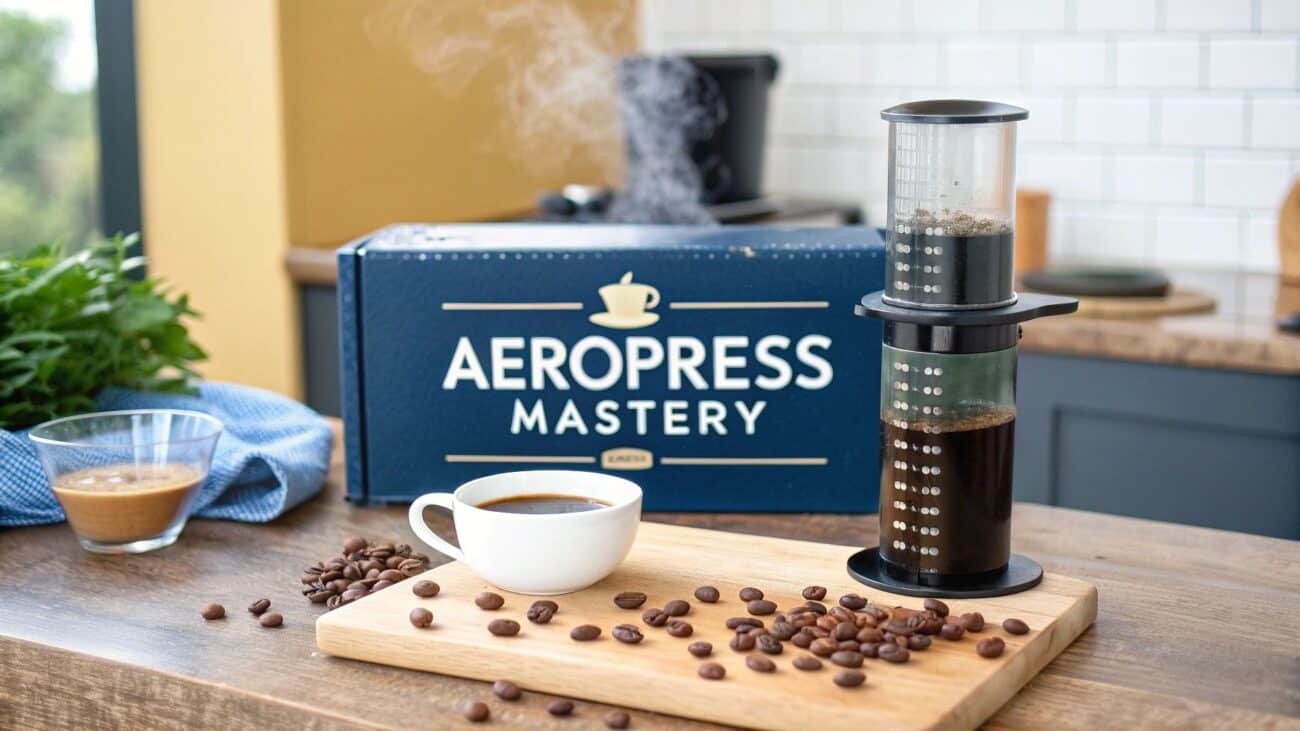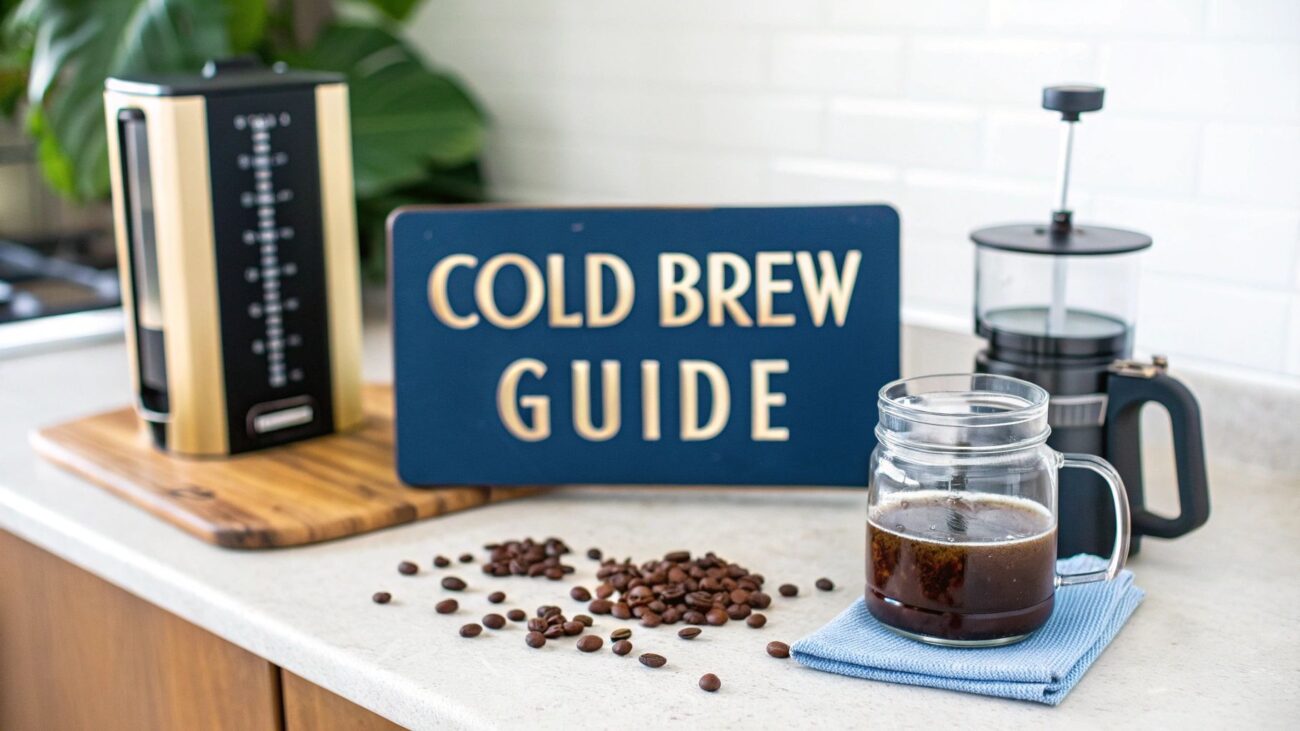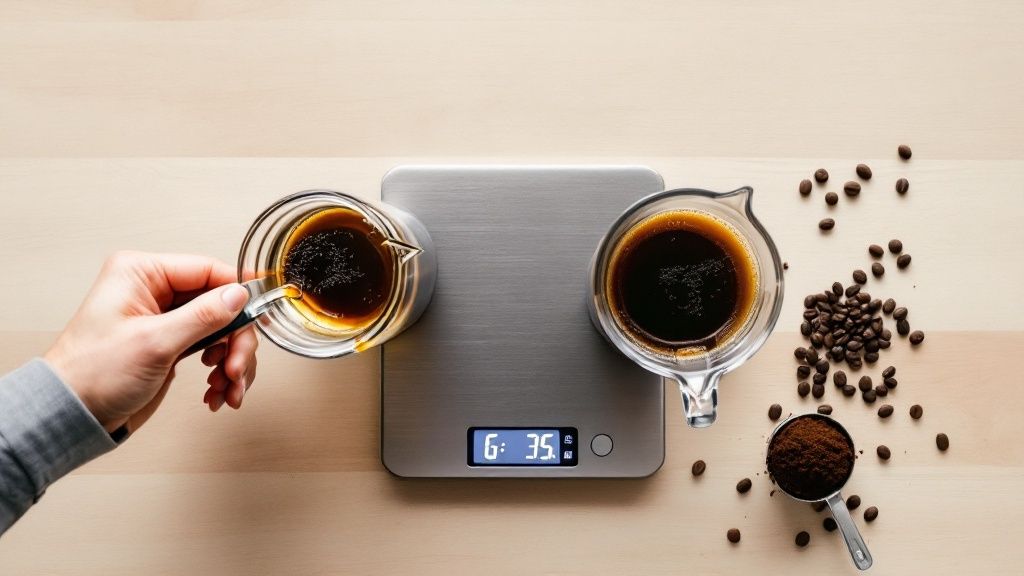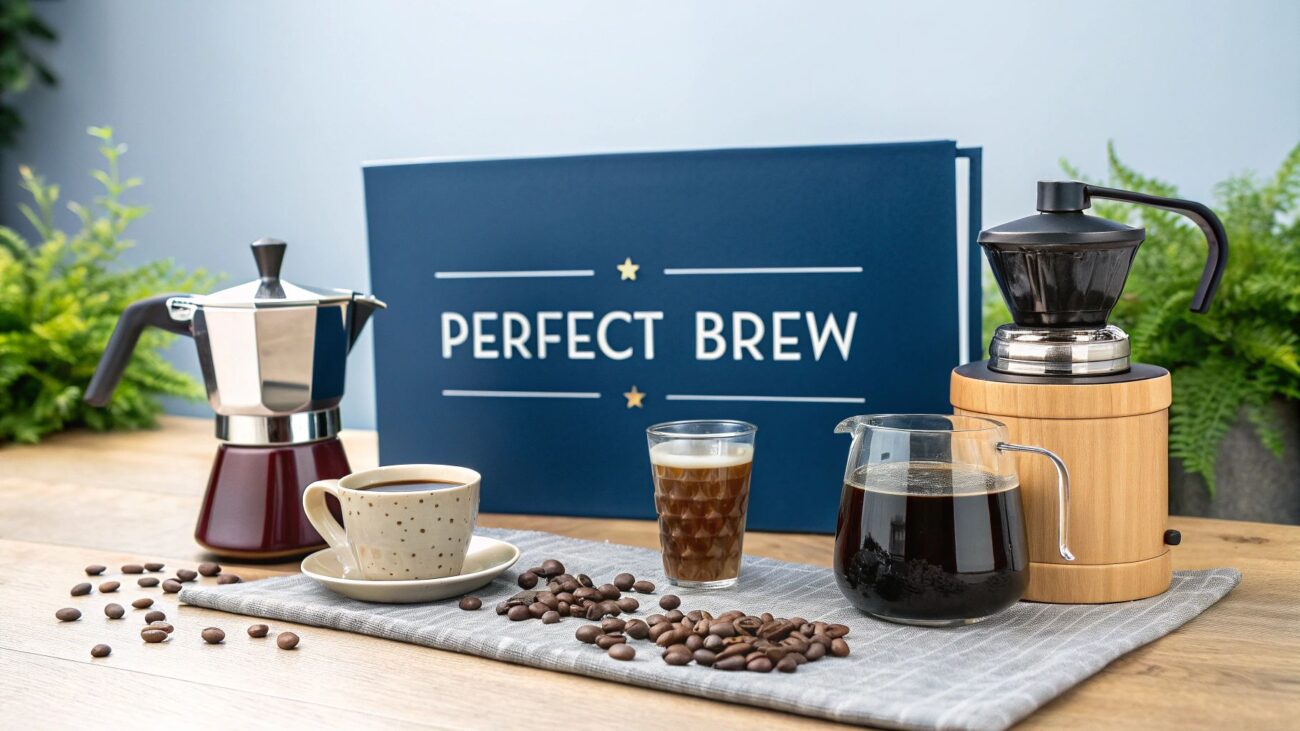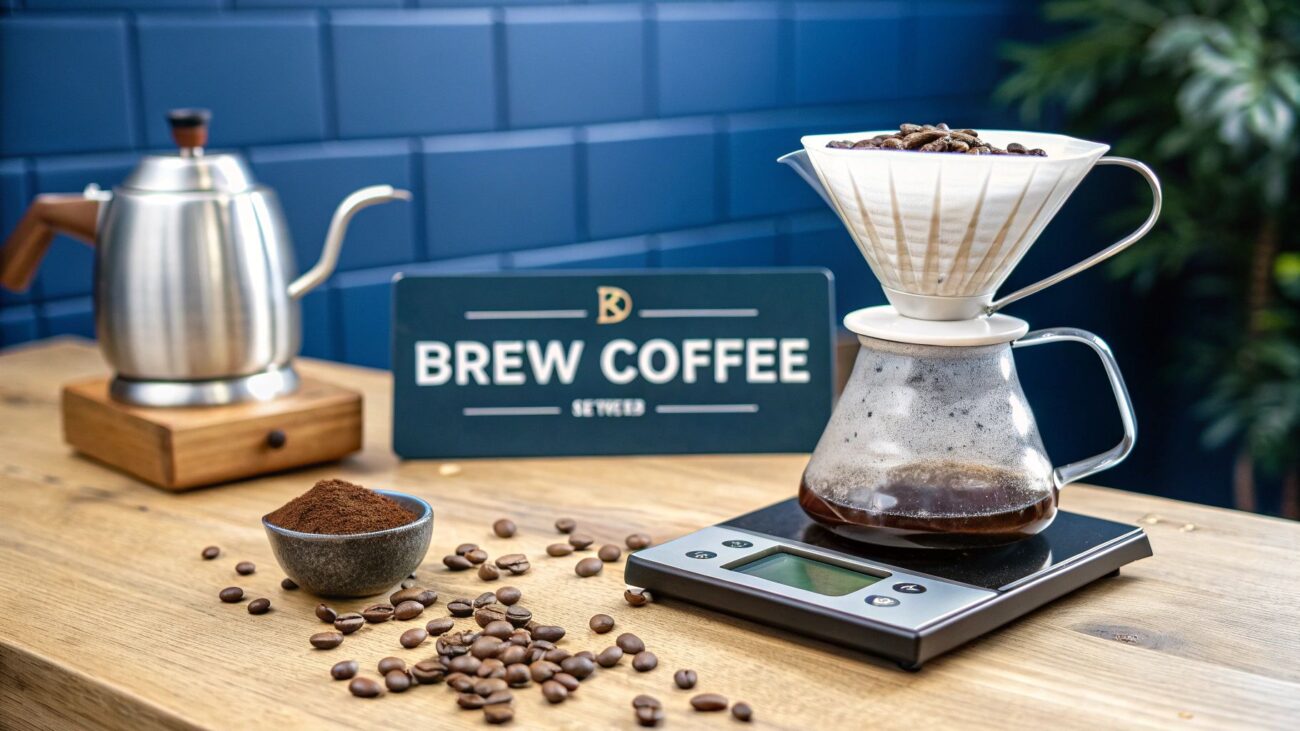How to Brew Coffee Perfectly at Home
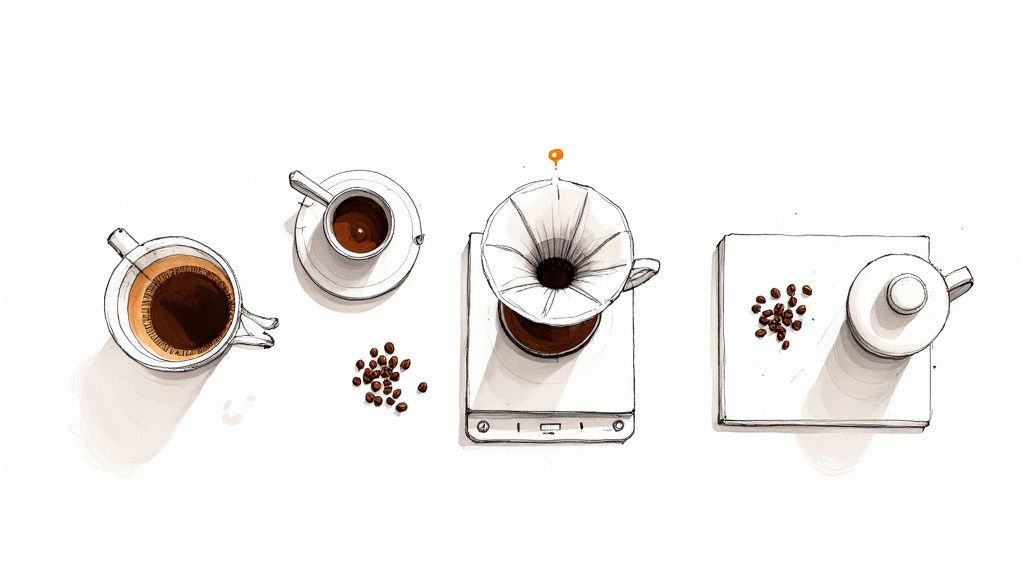
Learning how to brew great coffee at home isn’t about splashing out on complicated machines. The real secret to a fantastic cup lies in mastering a few core principles—things like how fresh your beans are, the size of your grind, and the temperature of your water.
Once you nail these fundamentals, you'll be able to make café-quality coffee right in your own kitchen, consistently.
The Foundations of a Flavourful Brew
The UK’s coffee scene has absolutely exploded. We've moved far beyond instant granules, and more and more of us are finding real joy in the craft of turning a simple bean into a delicious, aromatic drink. That journey doesn't start with a fancy gadget; it starts with a bit of know-how.
Understanding these core elements is what gives you control over the final taste in your cup. It’s the difference between a flat, lifeless brew and one that sings with character and vibrancy. Think of these as the building blocks for every great coffee you'll ever make.
Key Factors for a Perfect Brew
Before we dive into specific brewing methods, let's get to grips with the four pillars that dictate flavour extraction. Get these right, and your coffee will improve dramatically, whether you're using a French press or a high-end pour-over dripper.
- Bean Freshness: Coffee beans are at their absolute best within a few weeks of being roasted. The moment they're ground, they start to lose those precious aromatic oils. Grinding your beans just before you brew is probably the single biggest upgrade you can make to your coffee routine.
- Grind Size: This is all about how quickly water can pull flavour from the coffee. A fine grind has a huge surface area, perfect for quick extraction methods. A coarser grind, on the other hand, needs more time with the water to get the job done right.
- Water Temperature: The sweet spot for brewing water is between 92–96 °C. If your water is too hot, you'll scald the grounds and end up with a bitter, harsh taste. Too cool, and your coffee will be weak, sour, and under-extracted.
- Brew Time: This is simply how long the water and coffee are in contact. Every brew method has an ideal time frame to hit that perfect, balanced extraction.
The single greatest factor in a flavourful cup is the quality and freshness of the beans themselves. Storing them correctly is just as important as buying them fresh. You can learn more about how to store coffee beans to preserve their character and extend their life.
Getting a feel for these fundamentals is the first real step on your path to becoming a skilled home barista.
Using a French Press for a Rich and Full-Bodied Coffee
The French press, or cafetière as it’s often known here in the UK, is a classic for a very good reason. It uses an immersion brewing technique where the coffee grounds steep directly in hot water, creating a cup with a wonderfully rich texture and heavy body. It’s a straightforward method that rewards you with bold, unfiltered flavour.
Mastering the French press is all about getting a few key variables right. Unlike brewers that use paper filters, the cafetière’s metal mesh filter allows all the coffee’s natural oils and some fine sediment to pass straight into your cup. This is precisely what gives French press coffee its signature character.
Getting the Grind and Temperature Just Right
The most crucial element for a clean brew is the grind size. You absolutely need a coarse grind—think of the texture of rough sea salt. If your grind is too fine, it will slip right through the mesh filter, leaving a sludgy, unpleasant mess at the bottom of your mug and causing over-extraction.
For the water, you're aiming for just off the boil. Around 93°C is the sweet spot. A simple trick if you don't have a thermometer is to let your kettle rest for about 30-45 seconds after it clicks off. This slight drop in temperature stops you from scalding the grounds, which would otherwise create a bitter, harsh taste.
The Brewing Process Perfected
First things first, add your coarsely ground coffee to a pre-warmed cafetière. A solid starting point for your coffee-to-water ratio is around 60 grams of coffee per litre of water. Feel free to adjust this to your own taste; for a stronger morning kick, you might bump it up to 70 grams.
Pour just enough hot water to cover the grounds and let them sit for 30 seconds. This little step is known as the ‘bloom’. It allows trapped carbon dioxide to escape from the freshly roasted beans, which leads to a much more even and flavourful extraction.
After the bloom, pour in the rest of your hot water and give it a gentle stir to make sure all the grounds are saturated. Pop the lid on with the plunger pulled all the way up and set a timer for four minutes. This is the classic brew time for a French press, and it’s a great place to start.
The four-minute mark is a guideline, not a strict rule. If you prefer a bolder, more intense flavour, try extending the brew time to five minutes. For a lighter cup, three minutes might be your sweet spot. Experimentation is key to finding what you love.
When your timer goes off, press the plunger down slowly and steadily. If you plunge too quickly, you'll agitate the coffee grounds at the bottom, forcing fine particles back up into your brew and creating bitterness. Once it's fully plunged, pour the coffee immediately to stop the extraction process in its tracks.
The French press is just one of many fantastic ways to make coffee, each offering a unique profile. You can explore more options by reading our guide on the best coffee brewing methods to find the perfect match for your taste.
Brewing a Clean and Nuanced Cup with Pour-Over
If you’re the kind of coffee drinker who really appreciates the subtle, delicate notes in a cup, then the pour-over method is for you. Unlike immersion brewers like the French press, pour-over is a percolation method. This simply means water continuously passes through the coffee grounds, leading to a brew celebrated for its exceptional clarity, brightness, and clean flavour.
Using a device like the iconic Hario V60 or a Chemex puts you in complete control of every single variable. It's a hands-on approach, for sure, but it’s also incredibly rewarding. You get to highlight the specific characteristics of your chosen beans, whether they’re floral and fruity or sweet and acidic.
Mastering Your Pour-Over Technique
The real secret to a brilliant pour-over lies in precision and consistency. First things first: your grind size is paramount. You’re aiming for a medium-fine grind, something with a texture similar to table salt. This creates the perfect amount of resistance for the water, ensuring it extracts flavour evenly without rushing through (which gives you weak coffee) or taking too long (hello, bitterness).
A gooseneck kettle is another non-negotiable tool for this method. Its long, slender spout gives you unparalleled control over the water's flow rate and where you direct it. This precision is exactly what helps you unlock those nuanced flavours that make pour-over so special.
Optimising your water is a critical first step, and this diagram really brings that point home.
As you can see, starting with good quality filtered water and keeping the temperature stable between 92–96°C is the foundation for any successful brew.
The Art of the Pour
Before you even think about adding coffee, place your filter in the dripper and give it a thorough rinse with hot water. This does two things: it gets rid of any papery taste and, just as importantly, pre-heats your brewing device and server. Tip that water out, then add your ground coffee.
Now, start your timer and begin the 'bloom'. This is where you pour just enough water to wet all the grounds—about twice the weight of your coffee (so, 40ml of water for 20g of coffee). Let it sit for 30-45 seconds. You’ll see the coffee bed rise and bubble as it releases trapped CO2. It’s a beautiful sight.
After the bloom, continue pouring in a slow, steady, circular motion. Start from the centre and work your way outwards, but try to avoid pouring directly onto the filter paper itself. This ensures you’re extracting flavour from all the grounds evenly. Your total brew time should land somewhere between 2:30 and 4:00 minutes, though this will vary depending on your specific device and recipe.
A fantastic starting ratio for any pour-over is 1:16—that’s one part coffee to sixteen parts water (e.g., 20g of coffee to 320g of water). But don't be afraid to tweak this. A 1:15 ratio will give you a stronger cup, while a 1:17 ratio will be a bit more delicate.
The UK's passion for great coffee is undeniable. With around 98 million cups consumed daily, the nation's appreciation for methods like pour-over just keeps growing. This enthusiasm is clear when you learn that approximately 80% of UK adults visit coffee shops every week, seeking out these expertly crafted brews.
For those using the ever-popular Hario device, getting the technique just right can take a bit of practice. To help you nail it, our detailed guide on V-60 coffee brewing offers more specific tips to help you master this fantastic brewer.
Mastering the AeroPress for Versatility and Speed
The AeroPress is a true modern marvel in the coffee world. It’s loved for its incredible speed, impressive versatility, and its knack for producing a consistently smooth, low-acidity brew.
If you want exceptional coffee without the usual fuss, this unique device is your perfect companion. It’s one of the few brewers that’s just as at home in a top-tier speciality cafe as it is packed in a hiker's rucksack.
What makes the AeroPress so beloved is its clever hybrid approach. It combines immersion (letting the grounds steep in water) with pressure (plunging the coffee through a filter). This allows for a remarkably quick extraction, often in just one to two minutes, without sacrificing depth of flavour.
Choosing Your Brewing Method
With the AeroPress, you have two main ways to brew: the standard method and the ‘inverted’ method. Neither is better than the other; they just offer different levels of control and produce slightly different results.
-
Standard Method: This is the technique you'll find in the instructions. You place the AeroPress right onto your mug, add your coffee and water, give it a stir, and plunge. It’s fast, simple, and virtually foolproof, making it a brilliant starting point.
-
Inverted Method: This technique involves flipping the brewer upside down, so the plunger is at the bottom. This stops any coffee from dripping through before you're ready to press, giving you total control over the steeping time. It's a favourite among enthusiasts who love to fine-tune their recipes.
Getting the Fundamentals Right
To get the most out of your AeroPress, you'll want a fine-to-medium grind—something a touch finer than you'd use for a pour-over but coarser than for espresso. This provides the ideal surface area for a quick, complete extraction under pressure.
Your water temperature should also be a little cooler than for other methods, typically between 80–90°C. Because the brew is so fast, hotter water can easily lead to over-extraction and bitterness.
One of the AeroPress’s greatest strengths is how forgiving it is. Unlike more sensitive methods, small variations in grind size or water temperature won't ruin your cup. This makes it an excellent brewer for experimenting and finding what works for you.
Because you can brew in so many ways with this device, it's a fantastic tool for any coffee lover. You can produce everything from a short, concentrated espresso-style shot to a longer, Americano-style drink simply by tweaking your coffee-to-water ratio and adding more hot water after brewing.
If you’re ready to dive in, you can find a great AeroPress coffee brewer to begin your journey.
Cleaning up is another area where the AeroPress truly shines. Once you’ve plunged, you just unscrew the cap and push the plunger the rest of the way. The puck of compressed grounds pops straight into the bin, and a quick rinse is all it needs. This hassle-free clean-up, taking mere seconds, is a huge part of its appeal for a daily brew.
Simple Adjustments for Better Tasting Coffee
Once you've got a handle on your chosen coffee maker, there are a few universal principles that will elevate just about any cup you brew. These aren't complicated, gear-heavy changes. They’re small, practical adjustments that can dramatically improve the final taste in your mug, turning a daily ritual into a true craft.
The journey to a truly great coffee experience starts long before water even touches the grounds. It begins with the beans.
Start with Superior Ingredients
The single most impactful change you can make is to use freshly roasted, whole beans. It's a game-changer. Coffee beans hit their flavour peak within just a few weeks of being roasted. That pre-ground stuff from the supermarket? It might be convenient, but it loses its precious aromatic oils and delicate compounds incredibly fast because of all that exposed surface area. Grinding your beans just moments before you brew is non-negotiable for a vibrant, flavourful cup.
Just as crucial is the water you’re using. Coffee is over 98% water, so its quality has a massive effect on how the flavours are extracted. Tap water, especially in the hard water areas common across the UK, is full of minerals that can mute the delicate notes in your coffee, leaving you with a dull or even chalky taste.
Always opt for filtered water. You don't need a fancy system; a simple charcoal filter jug is enough to strip out the impurities and give you a clean, neutral base. This simple switch lets the coffee’s true character—whether it’s the fruity zing of an Ethiopian Yirgacheffe or the chocolatey richness of a Brazilian—really shine through.
Precision Makes Perfect
Consistency is what separates a good cup of coffee from a great one you can make again and again. Ditching the scoop for a simple digital kitchen scale is one of the best moves you can make if you're serious about your coffee. Measuring your beans and water by weight allows you to dial in your brew ratio with absolute precision.
A brilliant starting point is a 1:16 ratio. That’s one part coffee to sixteen parts water (for example, 20 grams of coffee to 320 grams of water). Using a scale takes all the guesswork out of the equation and ensures you get a balanced extraction every single time.
Finally, a tiny detail that makes a big difference: don’t overlook the temperature of your brewing equipment.
- Pre-heat your brewer: A quick rinse of your French press, V60, or AeroPress with hot water stops the device from stealing heat and shocking the coffee slurry with a sudden temperature drop.
- Warm your mug: Pouring your perfectly brewed coffee into a cold mug instantly cools it down. A quick splash of hot water in your mug while you brew makes a surprising difference to that first sip.
This kind of attention to detail is exactly what younger coffee drinkers are looking for. We're seeing trends among millennials and Gen Z showing a strong preference for artisan blends and traceable, ethically sourced beans. It reflects a bigger shift towards both quality and consciousness. UK coffee lovers want to know the story behind their cup, from where it was grown to its environmental footprint. To get a better feel for these evolving tastes, you can find more insights into UK coffee consumption statistics on yorkemporium.co.uk.
Common Home Brewing Questions Answered
Once you start diving into the world of home brewing, it’s completely normal for a few questions to crop up. Getting your technique dialled in is a journey, not a destination, and a bit of troubleshooting is all part of the fun. Here, we tackle some of the most common queries we hear from aspiring home baristas.
From battling bitter brews to wondering how on earth to store your beans, these are the hurdles pretty much everyone faces at the start. A little bit of know-how can solve most of these issues and get you back on track to making consistently delicious coffee.
Why Does My Coffee Taste Bitter?
Ah, the dreaded bitter cup. More often than not, bitterness is a tell-tale sign of over-extraction. This simply means the hot water has spent too much time with the coffee grounds, pulling out all the good stuff and then starting on the unpleasant, bitter-tasting compounds. It’s a common problem, but thankfully, it's usually an easy fix.
Let's look at the three main culprits:
- Your grind is too fine: Think of it like this—a finer grind has a much larger surface area, which really speeds up extraction. If it’s too fine for your brew time, you’ll race past the sweet spot straight into bitterness. Try dialling your grinder back to a slightly coarser setting.
- Your brew time is too long: Letting your coffee sit and steep for too long is like an open invitation for those bitter notes to join the party. Try shaving 30 seconds off your brew time and see what a difference it makes.
- Your water is too hot: Water straight off the boil can literally scorch your coffee grounds, leading to a harsh, bitter flavour. After your kettle clicks off, give it a minute to cool down. You're aiming for that sweet spot between 92–96°C.
Does the Water I Use Really Matter?
In a word: absolutely. Your finished cup of coffee is over 98% water, so the quality of that water has a massive impact on the final taste. If your tap water is particularly hard or has a distinct chlorine taste, those flavours will come through in your brew, masking the delicate notes of the coffee itself.
Using filtered water gives you a clean, neutral canvas to work with. It allows the coffee’s true character to shine through—all those beautiful fruity, floral, or chocolatey notes that the roaster worked so hard to develop. It’s a simple change, but one that makes a world of difference.
When you brew coffee, you are creating a complex chemical solution. The mineral content of your water directly affects how efficiently flavour compounds are extracted from the grounds. Filtered water creates the ideal conditions for a balanced and flavourful extraction.
What Is the Best Way to Store Coffee Beans?
To keep your beans tasting their best, the golden rule is to store them in an airtight, opaque container at room temperature. The four biggest enemies of fresh coffee are oxygen, light, heat, and moisture. That’s why you should avoid the fridge or freezer at all costs—condensation is a killer for coffee beans, and they can easily absorb any stray odours lurking in there.
The main goal is to protect the delicate aromatic oils locked inside the beans. I always recommend buying smaller bags more often. This way, you’re always brewing with coffee that's nice and close to its roast date, which is the secret to a truly exceptional cup.
Interestingly, how much coffee we drink can vary by profession. Recent surveys of UK workers found that journalists and media staff are the biggest coffee drinkers, averaging 3.62 cups per day. You can discover more insights about UK coffee consumption trends on gcrmag.com.
And for a different kind of brew, especially for warmer days, you might be interested in our guide on how to make cold brew coffee, a smooth and refreshing alternative.
Ready to put your new knowledge into practice with beans that are roasted to perfection? Explore the exceptional range at Seven Sisters Coffee Co and discover your new favourite blend today. Visit us at https://sevensisterscoffee.co.uk.





